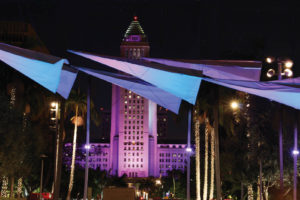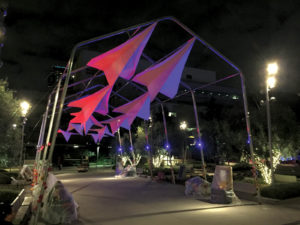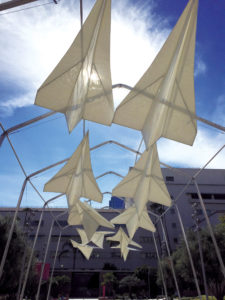Canvas Specialty, Inc. works through challenges to create a shade structure that is also art.

The simplicity of the paper airplane has made it a popular toy for generations of kids (and adults), even in this age of high-tech entertainment. But while the shade structure installed recently in Los Angeles’ Grand Park was designed to resemble a fleet of paper airplanes, creating an enlarged version of a childhood plaything was hardly simple, according to Greg Naiman, president of Canvas Specialty Inc., the Los Angeles, Calif., company that designed, engineered and built it.
Fortunately, Naiman says, “We’re an organization that embraces projects that present the kind of challenges this one did.”
The structure, dubbed “Paper Airplane,” was installed last September and consists of 11 individual paper airplanes, each 15 feet long and 10 feet wide and suspended independently 15 feet above the ground. The planes are made of coated mesh with a polyester scrim and held together by aerospace-grade aluminum cabling and sailboat hardware. The translucent fabric offers protection from UV rays and allows anyone viewing it to see that the fabric is folded like the classic paper airplane.
SCOPE INCREASES
Canvas Specialty became involved in the nascent project about the time Grand Park opened in 2012 in downtown Los Angeles between City Hall and the Los Angeles Music Center—but it was a much less complex endeavor the way it was originally envisioned.

The Music Center, which runs the park, contacted Naiman about building a simple structure that would provide shade for visitors who might otherwise have a hard time finding it amid the park’s immature landscaping. At that point, Naiman says, the project was relatively straight-forward, but that changed when the Music Center received a $100,000 grant from an organization called MyLA2050 to make the shade structure an artistic statement.
A decision was made to stage a public design competition, which drew 59 entries. Paper Airplane, a design concept submitted by Los Angeles artists Elenita Torres and Dean Sherriff, was selected as one of three finalists and was then chosen the winner through a social media ballot. Sherriff is a conceptual designer for movies, and Torres is an art director in the advertising business.
When they first considered entering the competition, Torres and Sherriff went to the 12-acre park seeking inspiration.
“What we saw is that Grand Park is for the young and old, for business people and families—everyone, really,” Torres says. “We watched people and thought hard about what everyone would have in common. We wondered: what is something all these people would play with? That’s where the paper airplane came in. Everyone has made a paper airplane or played with one.”
FORM AND FUNCTION
In addition, says Sherriff, “We wanted something that you could identify from a distance, something that would be prominent and visually stunning, and would help bring people into the park. The paper airplane idea allowed some dimensionality. It would be both form and function instead of serving just one purpose.”

While the artists had a vision and a basic design, it was Canvas Specialty’s job, working with the Music Center as its client, to turn the vision into reality—within the previously established budget. That presented some challenges.
The first was completing the project with a budget that hadn’t accounted for the artistic component (nor the artists’ $15,000 commission for winning the competition).
“When they were applying for the grant, they asked if we could make the shade structure for $100,000,” Naiman explains. “We said we could do that, but it was assumed at that time to be a typical tension fabric structure with shade panels. Even when the idea of the paper airplane was first brought up, we thought it was just going to be artwork on the panels. Then we realized what they were looking at was really a 3-D structure that was really very big paper airplanes. That really changed the scope.”
Torres and Sherriff had originally envisioned airplanes that would be 25 feet long, but because the budget would not accommodate that size, Naiman says they were scaled back to the 15-foot length.
Another challenge, Naiman says, was that the underground parking lot sitting below the space where the paper airplanes were to be installed would limit the installation options available. “We had to make sure that whatever we designed could be built on that spot,” Naiman says. “There could be no huge footings that the garage below wouldn’t support.”
In addition, because food trucks needed to be able to park under the canopy, the airplanes could not be held in place from directly below.
Finally, the structure had to be able to be taken down to accommodate events in the park that might require use of the land occupied by the planes; and because there was no large area where the art could be stored, the planes had to fit, when disassembled, into a very small space.
PACK IT UP
“When you look at the airplanes, they appear to be fairly rigid, but they’re each just really a fairly flat frame with cabling that creates a lot of the shape,” Naiman says. “When you take the covers off and undo the turnbuckles, all the fittings have snap pins, like an umbrella, so they slide into a pretty small package. We designed and built it so the whole thing fits into a box that is only about three-feet cubed.”
“All of these were pieces to the project that were kind of transparent to the rest of the world,” according to Naiman. “But to the people putting it together, they were huge.”
Naiman says the Canvas Specialty team that worked on Paper Airplane included two project managers, two draftsmen and 10 metal and fabric manufacturing associates. The call for entries for the design competition went out last March, and the project was completed in August. Paper Airplane will remain in place for two years, when it is expected to be moved to another area of the park and, Naiman says, another design competition may be held to choose a replacement structure.
“In the end, all the various challenges we faced were what made it exciting,” Naiman says. “We embrace projects where we start with a good idea but we aren’t exactly sure what they’ll look like in the end.”
“That we were able to pull it off just reinforced to me how creative the people are that I work with,” he adds. “The attitude was always, ‘Just tell us what you need and we’ll figure out how to get it done.’”
Jeff Moravec is a freelance writer from Minneapolis, Minn.
 TEXTILES.ORG
TEXTILES.ORG


